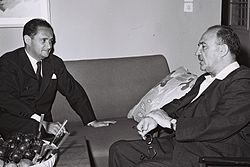Maurice Bourgès-Maunoury
This article needs additional citations for verification. Please help improve this article by adding citations to reliable sources. Unsourced material may be challenged and removed. Find sources: "Maurice Bourgès-Maunoury" – news · newspapers · books · scholar · JSTOR (August 2023) (Learn how and when to remove this message) |
Maurice Bourgès-Maunoury | |
|---|---|
 | |
| Prime Minister of France | |
| In office 13 June 1957 – 6 November 1957 | |
| President | René Coty |
| Preceded by | Guy Mollet |
| Succeeded by | Félix Gaillard |
| Personal details | |
| Born | Maurice Jean Marie Bourgès-Maunoury 19 August 1914 Luisant, Eure-et-Loir |
| Died | 10 February 1993 (aged 78) Paris |
| Political party | Radical |

Maurice Jean Marie Bourgès-Maunoury (French pronunciation: [mɔʁis buʁʒɛs monuʁi, moʁ-]; 19 August 1914 – 10 February 1993) was a French Radical politician who served as the Prime Minister in the Fourth Republic during 1957.[1]
Bourgès-Maunoury was born in Luisant, Eure-et-Loir. He is best known for fulfilling a prominent ministerial role in the government during the 1956 Suez Crisis.[2]: 49–50
Prime minister[edit]
He became Prime Minister in June 1957. While he was Prime Minister, the French Government achieved Parliamentary ratification of the Treaty of Rome, which led to the creation of the European Economic Community. He was succeeded as Prime Minister in November 1957 by Félix Gaillard.[3]
Controversy[edit]
As minister of Interior, he nominated the controversial Maurice Papon at the head of the Prefecture of Police in 1958, functions which he kept during the 1961 Paris massacre.
Death[edit]
He died in Paris in 1993.[3][citation needed]
Bourgès-Maunoury's Ministry, 13 June – 6 November 1957[edit]
- Maurice Bourgès-Maunoury – President of the Council
- Christian Pineau – Minister of Foreign Affairs
- André Morice – Minister of National Defense and Armed Forces
- Jean Gilbert-Jules – Minister of the Interior
- Félix Gaillard – Minister of Finance and Economic Affairs
- Édouard Corniglion-Molinier – Minister of Justice
- René Billères – Minister of National Education, Youth, and Sports
- André Dulin – Minister of Veterans and War Victims
- Gérard Jaquet – Minister of Overseas France
- Édouard Bonnefous – Minister of Public Works, Transport, and Tourism
- Albert Gazier – Minister of Social Affairs
- Max Lejeune – Minister of Sahara
- Félix Houphouët-Boigny – Minister of State
References[edit]
- ^ Heisler, Mark E. (29 June 1959). "Ex French Premier Predicts Arabs, Israel to Live in Peace". Press of Atlantic City. p. 2. Retrieved 17 August 2023.
- ^ Crosbie, Sylvia Kowitt (8 March 2015). A Tacit Alliance: France and Israel from Suez to the Six Day War. Princeton University Press. ISBN 978-1-4008-6795-0.
- ^ a b Lentz, Harris M. (4 February 2014). Heads of States and Governments Since 1945. Routledge. pp. 291–292. ISBN 978-1-134-26490-2.
| Political offices | ||
|---|---|---|
| Preceded by | Minister of Public Works, Transport and Tourism 1950 |
Succeeded by |
| Preceded by —
|
Minister of Armaments 1952 |
Succeeded by —
|
| Preceded by | Minister of Finance 1953 |
Succeeded by |
| Preceded by | Minister of Commerce and Industry 1954 |
Succeeded by |
| Preceded by | interim Minister of Public Works, Transport and Tourism 1954 |
Succeeded by |
| Preceded by | Minister of the Armed Forces 1955 |
Succeeded by |
| Preceded by | Minister of the Interior 1955 |
Succeeded by |
| Preceded by | Minister of National Defence 1956–1957 |
Succeeded by |
| Preceded by | Prime Minister of France 1957 |
Succeeded by |
| Preceded by | Minister of the Interior 1957–1958 |
Succeeded by |
| |
| House of Valois (1518–1589) |
|
| House of Bourbon (1589–1792) |
|
| First Republic (1792–1804) |
|
| House of Bonaparte (1804–1814) |
|
| House of Bourbon (1814–1815) |
|
| House of Bonaparte (1815) |
|
| House of Bourbon (1815–1830) |
|
| House of Orléans (1830–1848) |
|
| Second Republic (1848–1852) |
|
| House of Bonaparte (1852–1870) | |
| Third Republic (1870–1940) |
|
| Vichy France (1940–1944) |
|
| Free France (1941–1944) |
|
| Provisional Government (1944–1946) | |
| Fourth Republic (1946–1958) |
|
| Fifth Republic (1958–present) |
|
| International | |
|---|---|
| National | |
| People | |
| Other |
This article about a Radical Party (France) politician is a stub. You can help Wikipedia by expanding it. |
